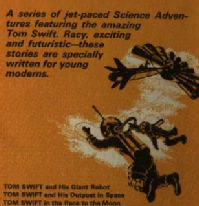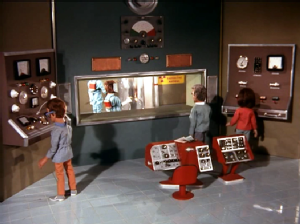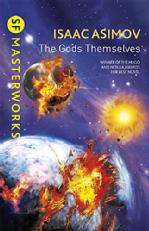Error and Trial
Trial and error is an essential element of the scientific process. However it is seldom portrayed accurately in popular culture - most fictional scientists either tend to solve every problem in short order, make paradigm-shattering breakthroughs, or fail in their experiments so catastrophically that it drives the narrative concerned. Here we take a look at the relatively rare representations of less clear cut and more fallible scientific investigations.
Swift Enterprises
 An interesting example of a scientist who progresses by trial and error in science fiction is Tom Swift Jr. Protagonist of a series of 33 novels published between 1954 and 1971 [1], Tom Swift Jr. was designed to appeal to adolescent boys during the blaze of interest in space science and atomic power which prevailed in the mid-twentieth century - indeed the back cover of the books claim they are written for “young moderns” (see image). The titular Swift is both an inventor, prototyping and building devices, and a scientist, understanding and exploring the underlying physics and publishing his results. He and his father head an experimental organisation called Swift Enterprises, which hands proven devices on to the largely-independent Swift Manufacturing Company (run by a family friend) for production and commercialisation.
An interesting example of a scientist who progresses by trial and error in science fiction is Tom Swift Jr. Protagonist of a series of 33 novels published between 1954 and 1971 [1], Tom Swift Jr. was designed to appeal to adolescent boys during the blaze of interest in space science and atomic power which prevailed in the mid-twentieth century - indeed the back cover of the books claim they are written for “young moderns” (see image). The titular Swift is both an inventor, prototyping and building devices, and a scientist, understanding and exploring the underlying physics and publishing his results. He and his father head an experimental organisation called Swift Enterprises, which hands proven devices on to the largely-independent Swift Manufacturing Company (run by a family friend) for production and commercialisation.
Like many scientists in fiction, Swift inevitably solves the vast majority of problems confronting him, usually with breakthroughs occurring unrealistically rapidly and problems solved by the end of each novel. However what makes him of interest in this context is the frequent occurrence of failure in these novels, and the way in which it is handled. In virtually every novel, Swift progresses towards his solution through a process of trial and error. It is not unusual for his experiments to go wrong - either in the initial design stage or after some device has been manufactured. Often these failures are minor, such as a series of new alloy samples not satisfying Swift’s hopes for them, but equally frequently errors are serious, with life-threatening consequences.
To take an example, in Tom Swift and his Spectromarine Selector (Appleton, 1960), Swift aims to enclose a newly-discovered underwater city in a protective dome and clean the long-abandoned buildings of marine accretion. This involves using three key inventions - his repelatron that can push back the water, his plastic tomasite for the protective dome and the brand-new, titular spectromarine selector which selectively vaporises the marine detritus while leaving the underlying material untouched. However the story is a catalogue of near-disaster. A prototype of this device was insufficiently selective and destroyed a purse it was meant to be cleaning during a demonstration. A later version accidentally produced cyanide gas as an output product, almost killing those using it, and then weakened the underwater tomasite dome, almost drowning those inside. Meanwhile Swift’s working crew were exposed to radiation and suffered fungal infections - again, with near-fatal results.
In other novels in the series, Swift's innovations and experiments routinely fail to work as expected or have unexpected consequences. They frequently render him (and his best friend, copilot Bud Barclay) unconscious, sometimes blow up, and on more than one occasion casts him adrift in deep space. Almost certainly, these events occur primarily due to an editorial requirement for frequent chapter cliffhangers, to extend the length of the plot and to inject pace. However the series is notable for how it deals with such failures. Where Tom Swift himself is responsible for the incident, he bounces back, learns from it and designs a remedy, often pushing himself through all-night sessions of experimentation and redesign, and occasionally taking days or weeks to find a solution. Where an employee is responsible (as in cases of human error in manufacture), they are gently rebuked but not punished; the manufacturing processes and quality inspection procedures are reviewed, and the project moves on. At no point is an accidental error or misunderstanding treated as a matter for dismissal, ongoing self-loathing or as a permanent black mark on a record. Fundamentally, Swift’s scientific and technical inventions are the result of a process of discovery - one in which mistakes and misunderstandings along the way are as important to readers as the eventual breakthrough which solves a problem. Swift Enterprises exists for this reason - as a research and development organisation - although the financial pressures of failure are buffered by frequent successes and by the commercial power of the Swifts’ more risk-averse construction empire.
Using One’s Brains
Another scientist portrayed as fallible, albeit less frequently and dramatically is the character Brains in television series Thunderbirds (TV, 1965-1966). Here inventor and scientific genius Brains is responsible for designing the Thunderbird craft used by International Rescue, and also suggests successful solutions to many of the situations in which his colleagues find themselves. In many ways he conforms to negative stereotypes of scientific genius: stuttering, myopic, physically weak and socially awkward, but coming up with situation-saving insights on a regular basis. However he is notable in that despite this his inventions do not always succeed first time.
 An interesting example can be found in the episode “City of Fire”. Here the story opens with International Rescue testing a new form of metal-cutting equipment, designed by Brains for use in debris clearing, showing their experimental set-up in the depths of the Tracy Island base. The gas used to form the blowtorch-like cutting flame is a new formula, known as oxyhydnite. However the gas causes the two men conducting the experiment to pass out. While later events demonstrate that the gas can be safely used when heated, the scenes demonstrate that Brains is not infallible and proceeds by experiment, with trial and error occurring behind the scenes of all his innovations. A similar (albeit more urgent) experimental process is shown in episode “Brink of Disaster” (in which Brains initially speeds up an out-of-control monorail train before finally slowing it down), while a more gradual series of trials is shown in the feature film Thunderbird 6 (1968) in which patriarch Jeff Tracy demands a new design from Brains and finds flaws in his suggestions time after time.
An interesting example can be found in the episode “City of Fire”. Here the story opens with International Rescue testing a new form of metal-cutting equipment, designed by Brains for use in debris clearing, showing their experimental set-up in the depths of the Tracy Island base. The gas used to form the blowtorch-like cutting flame is a new formula, known as oxyhydnite. However the gas causes the two men conducting the experiment to pass out. While later events demonstrate that the gas can be safely used when heated, the scenes demonstrate that Brains is not infallible and proceeds by experiment, with trial and error occurring behind the scenes of all his innovations. A similar (albeit more urgent) experimental process is shown in episode “Brink of Disaster” (in which Brains initially speeds up an out-of-control monorail train before finally slowing it down), while a more gradual series of trials is shown in the feature film Thunderbird 6 (1968) in which patriarch Jeff Tracy demands a new design from Brains and finds flaws in his suggestions time after time.
Call the Doctor
While later seasons of the long-running television series Doctor Who positioned the Doctor as an adventurer and freelance-hero, the earliest incarnations of the Doctor (played by William Hartnell, Patrick Troughton and to some extent also Jon Pertwee) frequently portrayed him as a scientist. In particular Hartnell’s First Doctor was frequently described this way, with some early stories suggesting his space-time vehicle, the TARDIS, was of his own design [2]. In these stories, and in the contemporary Doctor Who Annuals, the Doctor was occasionally shown as an experimental scientist, either in his own TARDIS laboratory or in the lab spaces he finds himself visiting.
One example of the Doctor as an experimental scientist can be found in the Second Doctor story “The Moonbase” (1967). Here, the personnel of the base are falling ill of a mysterious virus, and the newly-arrived Doctor is tasked with discovering its origins. He tries and fails to do this through laboratory testing, expressing his frustration when his efforts prove fruitless - and his irritation when companion Polly questions his scientific (in this case medical) credentials. Of course, in this story as in every other, he does eventually identify the source of the problem. Nonetheless, it adds to the tension of the story to see his unsuccessful attempts en route to his eventual conclusion.
By the end of the second Doctor’s era, the Doctor is far less frequently portrayed as an experimental scientist. Later Doctors, including those in the modern era (post-2005) do fairly frequently perform chemical analysis, devise formulae or deduce technical solutions to problems. However they are almost invariably shown as doing so very rapidly and successfully, with no obvious evidence for a realistic experimental process. Where the experiments of the Doctor or their companions do fail, this tends to be the cause of conflict, angst and recriminations.
Trial and Error
The above examples aren’t unique [4], but it’s undoubtedly rare for science fiction to engage with the laborious and time-consuming process of scientific investigation in any detail. In short form fiction (i.e. short stories, novellas etc) exploring such experimentation would take too long to also enable plot progression. However even in longer novels (and also feature-length films) writers have historically focussed on the final results of scientific enquiry (either positive or negative!) or on the personal, emotional or political context in which the inquiry takes place. The process itself is often neglected, glossed over or occasionally used to provide conflict or recriminations between characters. This may be for purposes of characterisation or as a commentary on the ways in which the trial and error of the scientific process can break down.
 An interesting example of the latter can be found in Isaac Asimov’s novel The Gods Themselves (1972). Here the focus in the first section is on a chance scientific breakthrough (i.e. no extensive experimentation involved), and the centre section considers an alien perspective, but the third section returns to human scientists. It discusses a scientist whose career is torpedoed by a more senior researcher, Hallam, for questioning the physics on which his own reputation is based. Even here, the long-winded process of trial and error, of testing, failure and ultimate discovery is minimised. However, importantly, the actions of Hallam are shown as contemptible as much for perverting the scientific method as for his personal pride. His actions show arrogance, fallibility, confirmation bias (i.e. willingness to agree only with results which agree with your preconceptions) and a selfish pride. All of these things are human traits, and occur in scientists as in others, but here they are taken to extreme - rather than accepting questioning as a normal and necessary part of the process of science, Hallam would rather risk the destruction of another man’s life... and of our entire planet.
An interesting example of the latter can be found in Isaac Asimov’s novel The Gods Themselves (1972). Here the focus in the first section is on a chance scientific breakthrough (i.e. no extensive experimentation involved), and the centre section considers an alien perspective, but the third section returns to human scientists. It discusses a scientist whose career is torpedoed by a more senior researcher, Hallam, for questioning the physics on which his own reputation is based. Even here, the long-winded process of trial and error, of testing, failure and ultimate discovery is minimised. However, importantly, the actions of Hallam are shown as contemptible as much for perverting the scientific method as for his personal pride. His actions show arrogance, fallibility, confirmation bias (i.e. willingness to agree only with results which agree with your preconceptions) and a selfish pride. All of these things are human traits, and occur in scientists as in others, but here they are taken to extreme - rather than accepting questioning as a normal and necessary part of the process of science, Hallam would rather risk the destruction of another man’s life... and of our entire planet.
This is a far cry from the routine and accepted failure mode of science seen in both the Tom Swift books and in Thunderbirds. It may not be a coincidence that these were both aimed at a juvenile audience (and so expressed aspirations for positive behaviour rather than fears of its worst negatives), and that these are both series rather than stand alone fictions. A series allows scientist protagonists to make errors at certain times and achieve successes at others, allowing more nuance than the more dramatic single-attempt successes or failures which drive the plots of individual narratives. Thus we also see examples of scientific experimentation through trial and error in serial science fiction television franchises such as Star Trek and Stargate [3]. In many cases scientists in these series are still seen jumping to the breakthrough and/or destructive failure conclusions of their research. However certain regular characters are permitted longer trial-and-error experimentation story arcs.
One instance of this can be seen in Dr Rodney McKay (in Stargate: Atlantis, TV, 2004-2009) who demonstrates the ongoing process of trying to understand and adapt alien technology across several seasons of episodes. This process involves routine trial and error, with occasional failures - as is the case in one episode when McKay becomes trapped in a personal shield device which does not permit food to pass through, and another when his team becomes infected by nanotechnology. However unlike the blasé acceptance of failure as a learning process seen in the Tom Swift books, these events tend to be associated with rebukes, recriminations and suggestions that they should be treated as triggers for emotional growth rather than just a revised scientific methodology. True, McKay is in life-and-death situations where others depend on his responsible behaviour, and a 45 minute episode offers less scope for repeated failure than a novel, but it is still interesting to note how much more critical of failure and risk averse modern science fiction serials are than the older examples mentioned above.
Strings of failed experiments are never going to make for good entertainment. However the popular portrayal of scientists as infallible or as geniuses, able to solve any problem at a moment's notice, ultimately perpetuates a false and damaging stereotype. It discourages many from entering the sciences due to doubts regarding their own self-efficacy, and puts off many others who are initially enthusiastic become disillusioned by the grinding, often tedious and frustrating work of scientific experimentation. Normalising trial and error as a key part of the perceived scientific process might help the public understand the steps necessary to develop the scientific breakthroughs on which they depend, and the need to support fundamental research. While some science fiction, notably the Tom Swift books, has gone some way towards meeting this goal, it is clear that many other science fiction narratives are far from embracing scientific research in all its tedious glory.
"Error and Trial", Elizabeth Stanway, Cosmic Stories blog, 15th January 2023
Notes
[1] All Tom Swift Jr novels were published pseudonymously under the pen name Victor Appleton II. Like many franchises, the world of Tom Swift is periodically rebooted, with fiction featuring an inventor/scientist of this name appearing almost continuously between 1911 and the present. In the 1950s-60s series, the adolescent title character is the son of the protagonist from the series' first run. [Return to text]
[2] Later retconning clarified that the TARDIS was stolen from the Doctor’s own alien species. The two 1960s movies, staring Peter Cushing as “Dr. Who”, certainly indicated that the Doctor was the inventor. [Return to text]
[3] Although curiously, the television series Eureka (aka A Town Called Eureka) still focusses on the breakthrough/disaster of the week format rather than showing more realistic trial and error, despite being about a town dominated by scientists. [Return to text]
[4] Other examples can often be found in the open chapters of novels describing more spectacular scientific successes - for example in the Robert Heinlein juvenile novel Rocket Ship Galileo (1947), the story opens with the last of many failed rocket tests undertaken by the young protagonists - a failure accompanied by a philosophical shrug and a discussion of what was learned. However the rest of the book deals with an adventure in which no failure can be countenanced. [Return to text]
All ideas and opinions expressed here are the author's own and do not necessarily reflect those of the University of Warwick. All images sourced from public sites online and used here for fair comment.
